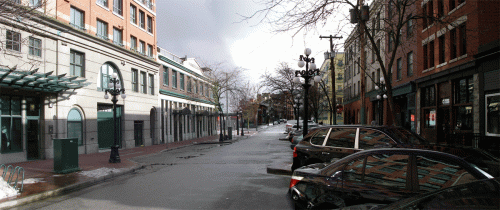Alexander Street in Gastown
The unit block East Alexander Street presents a microcosm of a workable housing strategy: Social Mix. In this photo we see co-op housing, social housing, affordable housing, and hi-end condominiums all on the same city block. To the Charrette this looked like Sustainable urbanism.
Yet, before we can contemplate redevelopment in the historic quartiers guarantees must be put in place to safe-guard against gentrification. For our purposes gentrification takes place when a low income population is displaced by a new, more mobile, higher income group. The safeguards we have in mind include:
For our purposes gentrification takes place when a low income population is displaced by a new, more mobile, higher income group. The safeguards we have in mind include:
- Zero-tolerance for homelessness (i.e. building all the social housing units necessary to house the homeless).
- Implement transportation to return traffic volumes to neighbourhood levels of service, on local streets so these may support social functioning once again.
- Build Co-op Market Buildings to provide space for businesses serving the low income sector.
- Build urban rooms and public open spaces on freed up rights off way to support social mixing. Pair urban rooms with Co-op Market Buildings providing space for outdoor fairs, markets & celebrations.
- Use the urban house or New Vancouver Special building type for social housing, so that it looks like every other house on the block. Don’t put social housing in towers.
The Social Face of Homelessness
Sustainable urbanism must incorporate social housing. Vancouver’s homeless are:
- 80% one or more of: addiction, mental health, HIV, other chronic
- 60% trauma victims
- 50% released from government care (foster care, group home, corrections) [Kraus, 2010]
- 33% aboriginal
- 10% Out-of-province
“Housing and Homeless Strategy”, City of Vancouver, 1 February 2011
In spring 2011, a CBC radio interview suggested that the cost ‘to the system’ of homelessness can be measured as
- $80,000 Federal Incarceration
- $70,000 Provincial Incarceration
- $55,000 Street Homeless (cost on the system—”Housing and Homeless Strategy,” City of Vancouver, 2011)
- $45,000 Housed with supports
Taking these numbers as accurate, it will cost our society a great deal to provide social housing and supports. However, it will cost even more not to do it.
Mosaica, San Francisco Mission District
.
Pictured above: Mosaica, San Francisco Mission District. 151 residential total units. Mix of uses in the building includes: light-industrial workshops; low-income family housing; supportive housing; subsidized housing; market-rate condominiums and community space (Design: WRT/Daniel Solomon E.T.C.).
.
Social Housing Principles
Social Housing should be part of the regional system, incorporated into neighbourhood planning from the outset. Regions should maintain the number of social housing units necessary to end homelessness.
Regional systems
Regional systems evolve within either natural, or human-made boundaries connecting cities, villages, suburbs, rural areas, parks, and wilderness at scales far beyond the reach of human scale.
Regional systems provide growth boundaries and land reserves; protect wilderness; integrate water, sewer and waste management; generate power from renewable resources; plug into power and communication grids; implement transportation; and provide for education, health care, and social housing.
System planning at the regional scale, and urban design at the scale of the quartier, should proceed in tandem in order to maximize sustainability, quality of life, and return on public investment.


